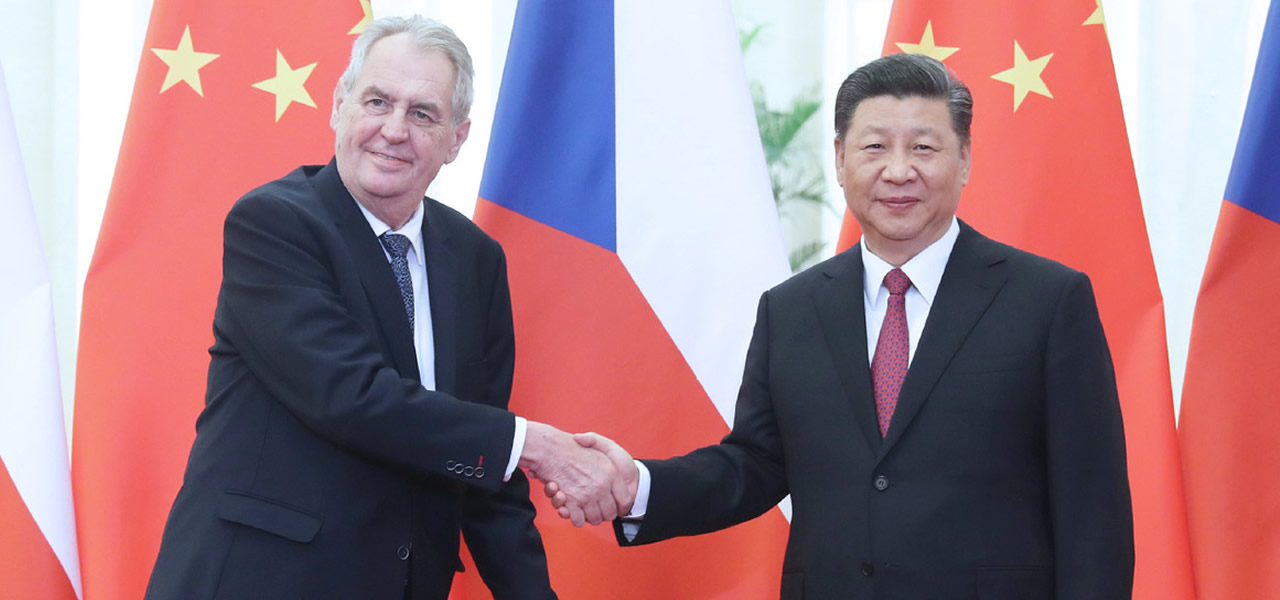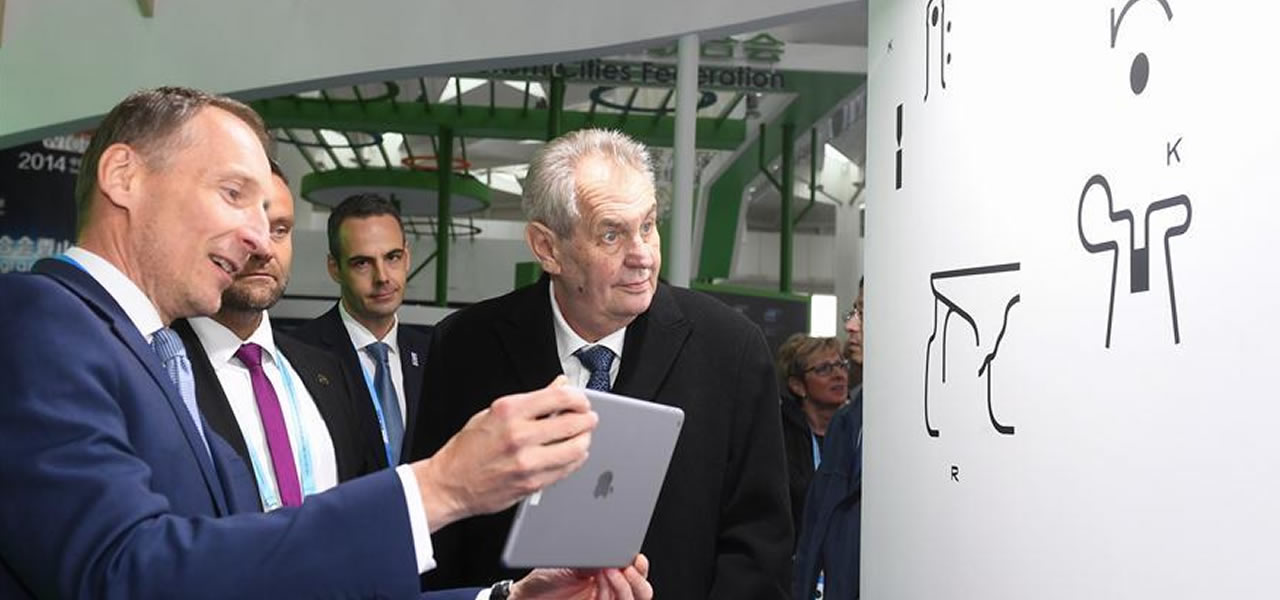President Xi Jinping meets with Czech President Milos Zeman in Beijing, April 28, 2019. [Photo/Xinhua]


President Xi Jinping meets with Czech President Milos Zeman in Beijing, April 28, 2019. [Photo/Xinhua]

Czech President Milos Zeman visits the Czech Republic booth at the International Pavilion of the International Horticultural Exhibition 2019 Beijing, in Beijing, April 28, 2019. [Photo/Xinhua]

China Esteran Airlines
The European Council announced on Monday that its digital COVID-19 vaccination certificate, which is already in use in 12 countries, had been signed into law, paving the way for quarantine-free travel to return in the region.
The certificate allows for travel restrictions to be lifted across all 27 member states of the European Union, and will be available for specific non-EU countries, too.
With the system going live last month, the EU is ahead of schedule with the program that is officially due to start on July 1.
The European Commission first presented a proposal to create a COVID-19 certificate for free travel within the EU in March, and on May 20, lawmakers reached a provisional agreement. It has now passed its legislative process.
In a Twitter post on Monday, President of the European Commission Ursula von der Leyen said: “With the success of our vaccination campaign and this new EU certificate, we can all look forward to the summer, to traveling safely. And we are bringing back the spirit of an open Europe. Our Union is delivering.”
The commission said the certificate is free of charge, secure and accessible to all. It is available in digital format or on paper, and will be proof that a person has been vaccinated against COVID-19, tested negative, or recovered from an infection.
It highlighted that no-one will be banned from traveling if they have not been vaccinated, as the new certificate will not be a pre-condition to free movement across the bloc.
There is no discrimination against individuals who are not vaccinated, according to the commission.
“Persons who are not vaccinated must be able to continue to exercise their free movement rights, where necessary subject to limitations such as testing or quarantine/self-isolation,” a statement from the commission said.
Countries that have already begun using the digital certificate include Bulgaria, Czech Republic, Denmark, Estonia, Germany, Greece, Croatia, Spain, Lithuania, Latvia, Denmark and Poland.
The European Council had said previously that any nation planning to issue certificates needed to guarantee they would be “fully interoperable, compatible, secure and verifiable”.
Greece, which was one of the tourism-reliant nations firmly behind the original proposals for the certificate, announced over the weekend that it would shorten its nightly curfew as COVID-19 cases eased across the country.
Authorities are also relaxing restrictions on venue capacities and permitting live music at outdoor cafes and restaurants.
Switzerland’s government has said it will relax its rules on wearing face masks outdoors at the end of the month, and people with vaccination certificates will be allowed to visit clubs and discos, while shops, restaurants, and leisure and sports facilities would be allowed to raise capacity limits.
With holidaymakers in Europe now free to make travel plans, Britons are being told to stay at home, which has drawn criticism from the United Kingdom’s travel industry.
The government in the UK has been discouraging overseas vacations this summer, despite the nation’s successful vaccination rollout campaign. It is instead focused on promoting domestic tourism, while restrictions remain.
The British government announced on Monday that its June 21 target date for lifting restrictions would be delayed by four weeks, due to a rise in the number of infections caused by the so-called delta variant.
Flight bookings from countries within the EU to Spain and Greece reached near 50 percent of pre-pandemic levels in June, the Financial Times reported, while the number of UK to EU flights is just 20 percent of levels seen before the crisis.
EasyJet’s chief executive, Johan Lundgren, told the FT relaxation and removal of restrictions has “sparked a positive booking momentum across Europe”, adding: “Europe is demonstrating that a safe reopening of travel is possible and so we continue to urge the UK government to do so urgently.”
Andrew Flintham, managing director of tour operator Tui, told the FT “European countries are watching us with bewilderment”.
He added: “My counterparts in Germany, Belgium and the Netherlands are now seeing travel made possible again, with strong bookings for summer and the pent-up demand for travel we know exists in the UK as well.”
Corruption in Europe has worsened through the pandemic with nearly two-thirds of European Union residents estimated to believe it is a major problem, according to a survey conducted by anti-graft watchdog Transparency International.
Some citizens across the bloc relied on personal connections to access healthcare during the crisis, and governments are believed to have used the pandemic for their own gain, the report found.
The NGO’s report, Global Corruption Barometer-EU 2021, surveyed more than 40,000 people in the EU’s 27 member states between October and December last year, making it one of the largest, most detailed surveys of people’s views and experiences of corruption across the bloc.
It found that 29 percent of respondents had relied on favors or well-connected friends and family to access public sector health services last year, while 6 percent said they had resorted to paying an outright bribe. This is equivalent to more than 106 million people, said the authors of the report in a statement released on Tuesday.
The findings in the report are described as particularly worrying as governments across the EU are rolling out vaccinations to protect those most vulnerable to the virus and are creating plans to allocate billions of euros for post-pandemic recovery.
“Corruption threatens all these activities,” Transparency said, urging EU governments to “redouble their efforts to ensure a fair and equitable recovery from the ongoing pandemic”.
In addition, 62 percent believe that government corruption is a big problem in their country, almost one third think corruption is getting worse, and a further 44 percent think it is not getting any better.
“The EU is often seen as a bastion of integrity, but these findings show that countries across the region remain vulnerable to the insidious effects of corruption,” Delia Ferreira Rubio, chair of Transparency International, said in the statement.
Half of the respondents believe that “bribes or connections are commonly used by businesses to secure profitable government contracts, and that big companies often avoid paying their taxes”, the report said.
The survey also showed an average of 53 percent of people across the EU think their government is controlled by private interests.
This view was strongest in Slovenia, Bulgaria, Cyprus, Croatia and the Czech Republic, but it was a minority opinion in Scandinavian countries.
Michiel van Hulten, director of Transparency International EU, said the results should be a wake-up call for both national governments and EU institutions.
“There are many immediate actions that can be taken to remedy these problems, such as increasing lobbying transparency both at the EU and national levels and tackling tax avoidance,” he said. “And EU policies to protect whistleblowers and fight money laundering must be effectively and swiftly transposed into national law.”
In recent years, we have noticed that the Sustainable Apparel Coalition (SAC) has released the Higg Material Sustainability Index (Higg MSI). However, the one-sidedness and inaccuracy of the index on the environmental impact of silk have created considerable confusion and consternation among the global silk fraternity. This may create cascading effect on the livelihood opportunities to millions of stakeholders in the rural areas and producing mills all across the globe.
With a view to reflect the carbon neutrality and sustainability of silk products in a more comprehensive and objective manner, International Silk Union (ISU) joined hands with several organizations, such as International Sericultural Commission (ISC), Ufficio Italiano Seta (UIS), INTERSOIE France and Brazilian Silk Association (ABRASEDA), to table the following proposal:
Ⅰ. To question the method of developing Higg MSI scoring on silk
Higg MSI arrived the environmental impact value of silk as 1086, which is more than 30 times worse than synthetic fabric. The irrationality of its scoring was mainly manifested on the following aspects:
1. Higg MSI’s assessment of the life cycle of silk only stays at the stage from sericulture to fabric (that is, from “cradle to gate”). Refer to the international standards of ISO 14020:2000 Environmental labels and declarations-General principles and ISO 14040:2006 ISO 14040:2006 Environmental management — Life cycle assessment — Principles and framework, the life cycle assessment of silk products should be a research type from “cradle to grave”, which covers the production, use and disposal of silk ready to wear, silk apparels and silk home textiles. Silk is the “queen of fibers”, and its manufactured goods had a long service life and were eventually biodegradable. Therefore, the research from “cradle to grave” is more convincing, complete and scientific.
2. The evaluation indicators of Higg MSI only included “global warming potential”, “nutrient pollution in water / eutrophication”, “water scarcity”, “fossil fuel depletion” and “chemistry”. It should be added to comprehensively evaluate the environmental performance according to the Product Environmental Footprint Category Rules Guidance (PEFCR).
3. As manifested by relevant data, Higg MSI’s scoring data of silk originated from a paper called Life Cycle Assessment of Indian Silk published by Miguel F. Astudillo et al. on the Journal of Cleaner Production. The data in this paper were collected early than 2013, lack of timeliness, and using the data from individual countries or regions to evaluate the environmental impact of silk is not representative and comprehensive. It is understood that the research was carried out for a completely different purpose, not for the Higg Index.
4. Higg MSI didn’t and still does not make public its calculation method and is free from social supervision. The silk producers made nothing of the results and cannot trace their origins. By and by, the consumers’ negative perception on silk are being intensified and the producers’ confidence also severely blown.
II. To make a comprehensive and objective assessment of life cycle of silk products
In 2015, nearly 200 countries jointly adopted the Paris Agreement at the United Nations Climate Change Conference in Paris. Many countries have enacted low-carbon development strategies in succession. In 2020, China set out the goal of “achieve peak CO2 emissions before 2030 and carbon neutrality before 2060”. Britain boosted the reduction of greenhouse gas using two approaches, restriction and incentive, and identified low-carbon electricity as the core of low-carbon development. By formulating the National Programme for the Mitigation of Climate Change, France clearly defined the selecting and formulating principles of emission reduction measures.
It is a joint duty and commitment of the countries, silk academia, business circles and consumers to respond to the global low-carbon development strategies and facilitate the healthy development of silk industry. The international silk industry requires an open, comprehensive and objective assessment system for the life cycle of silk products, to steer the production and consumption of silk industry.
1. It is necessary and impelling to determine the boundaries of the assessment system which confirms to the current production and consumption of silk according to relevant international standards, as well as evaluate its environmental performance in the whole life cycle from sericulture, production, design, use, re-use, up cycling and disposal of silk products. The evaluated sustainability scores are validated by ISO and provided for public use and interpretation.
2. The evaluation sample should be comprehensive, representative and accurate. It should include major silk producing countries such as China, India and Uzbekistan, as well as silk manufacturers and consumers in Europe and the United States, involving the key links of silk production such as silk reeling, twisting, weaving, printing and dyeing, truly reflect the production technology and production conditions of the international silk industry, and the consumer behavior and consumption habits.
3. It is a compelling duty to divide the industrial chain in a rational way, make a comprehensive, deep and transparent as well as really traceable inventory analysis on each stage and gradually improve the life cycle assessment of silk products, so that a more open and transparent evaluation system that withstands the test of practice can be widely used applied the silk industry, and raise the awareness of environmental responsibility of the silk industry.
4. To actively seek policy support, fully exert the linkage between trade organizations and enterprises, allow high-quality and time-sensitive industrial data to be applied to the assessment system and objectively reflect the environmental performance of silk products. Promote market-oriented green technological innovation, standardize LCA research in the global silk industry, formulate Silk Product Category Rules (PCR), industry standards and sustainability indexes, guiding silk enterprises to green production.
5. Last but not least silk needs all of us to take the initiative to cultivate consumers’ green values and green spending habits, and give full value to the publicity function of the media platform, so that consumers can fully understand carbon neutrality, sustainability and ecological environment protection, and create a demand engine for the development of green silk industry.
Plan energy resources as a whole and advocate greenness and low carbon. We are liable to co-build a green home for silk. Industry organizations, enterprises and brands of International silk should pool efforts, seek common development, propel the comprehensive and objective assessment of the life cycle of silk products, and guarantee the healthy and sustainable development of the silk industry.